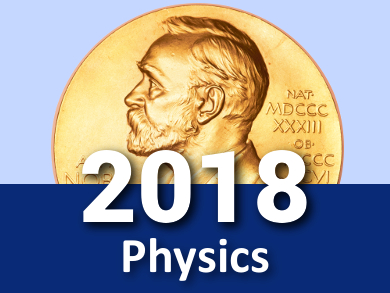The Nobel Prize in Physics 2018 has been awarded “for groundbreaking inventions in the field of laser physics” with one half to
- Arthur Ashkin, Bell Laboratories, Holmdel, USA,
“for the optical tweezers and their application to biological systems”
and the other half jointly to
- Gérard Mourou, École Polytechnique, Palaiseau, France, and University of Michigan, Ann Arbor, USA, and
- Donna Strickland, University of Waterloo, Canada,
“for their method of generating high-intensity, ultra-short optical pulses.”
Arthur Ashkin invented optical tweezers, which grab particles, atoms, viruses, or living cells with a laser beam. This new tool allowed Ashkin to use the radiation pressure of light to move physical objects. A gradient force in the laser beam pushes small particles towards the center of the beam and holds them there in a “light trap”. A major breakthrough came in 1987, when Ashkin used an infrared laser beam to capture living bacteria without harming them. Optical tweezers are now widely used to investigate biological systems.
In 1985, Gérard Mourou and his then Ph.D. student Donna Strickland developed a method to create extremely short and intense laser pulses. Their approach allowed them to create those high-intensity laser pulses without destroying the amplifying material. First, they stretched the laser pulses in time to reduce their peak power, then amplified them, and finally compressed them. If a pulse is compressed in time and becomes shorter, then the intensity of the pulse increases dramatically. The technique, called “chirped pulse amplification” (CPA), soon became standard for high-intensity lasers. Such lasers are used, e.g., in corrective eye surgeries.
Arthur Ashkin, born in 1922 in New York, USA, received his Ph.D. from Cornell University, Ithaca, USA, in 1952. From 1952 until his retirement in 1992, he worked at Bell Telephone Laboratories, Murray Hill, NJ, USA—first as a member of the technical staff, then as Head of the Department of Laser Science. At 96 years, Ashkin is the oldest Nobel Laureate at the time of the award so far.
Gérard Mourou, born in 1944 in Albertville, France, received his Ph.D. from the University of Paris, Orsay, France, in 1973. He performed postdoctoral research at San Diego State University, CA, USA. Starting in 1979, he worked at the University of Rochester, New York, USA. He joined the University of Michigan in 1988. Mourou also serves as Director of the Laboratory for Applied Optics at the École Polytechnique, Palaiseau.
Donna Strickland, born in 1959 in Guelph, Canada, received her Ph.D. in physics from the University of Rochester in 1989 under the supervision of Gérard Mourou. From 1988 to 1991, she was a Research Associate at the National Research Council of Canada and then joined the Lawrence Livermore National Laboratory, CA, USA. Strickland became Assistant Professor at the University of Waterloo in 1997 and was promoted to Associate Professor in 2002. Strickland is only the the third woman to receive the Nobel Prize in Physics.
Selected Publications by Arthur Ashkin
- Acceleration and Trapping of Particles by Radiation Pressure,
A. Ashkin,
Phys. Rev. Lett. 1970, 24, 156–159.
https://doi.org/10.1103/PhysRevLett.24.156 - Optical trapping and manipulation of single living cells using infra-red laser beams,
A. Ashkin, J. M. Dziedzic,
Ber. Bunsenges. phys. Chem. 1989, 93, 254–260.
https://doi.org/10.1002/bbpc.19890930308 - Optical trapping and manipulation of neutral particles using lasers,
A. Ashkin,
Proc. Natl. Acad. Sci. 1997, 94, 4853–4860.
https://doi.org/10.1073/pnas.94.10.4853
Selected Publications by Gérard Mourou and Donna Strickland
- Compression of amplified chirped optical pulses,
D. Strickland, G. Mourou,
Opt. Commun. 1985, 56, 219–221.
https://doi.org/10.1016/0030-4018(85)90120-8 - En route vers le Petawatt,
P. Maine, D. Strickland, P. Bado, M. Pessot, G. Mourou,
Rev. Phys. Appl. (Paris) 1987, 22, 1657–1663.
https://doi.org/10.1051/rphysap:0198700220120165700
- Generation of ultrahigh peak power pulses by chirped pulse amplification,
P. Maine, D. Strickland, P. Bado, M. Pessot, G. Mourou,
IEEE J. Quantum Electron. 1988, 24, 398–403.
https://doi.org/10.1109/3.137
Also of Interest
- Who’s Next? Nobel Prize in Chemistry 2018,
ChemViews Mag. 2018.
Make your predictions for the 2018 Nobel Prize in Chemistry
- Nobel Prize in Physiology or Medicine 2018,
ChemViews Mag. 2018.
The prize was awarded to James P. Allison and Tasuku Honjo for their discovery of cancer therapy by inhibition of negative immune regulation - Nobel Prize in Physics 2017,
ChemViews Mag. 2017.
The prize was awarded one half to R. Weiss, the other half jointly to B. C. Barish and K. S. Thorne for work on gravitational waves - The Nobel Prize,
Veronika Belusa,
ChemViews Mag. 2015.
Collection of information on the Nobel Prize




